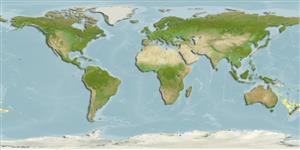Common names from other countries
Ελασμοβράγχιοι (καρχαρίες και σαλάχια) (sharks and rays) >
Squaliformes (Sleeper and dogfish sharks) >
Etmopteridae (Lantern sharks)
Etymology: Etmopterus: Greek, ethmos, -ou = sieve or ethmoides bone + Greek, pteron = wing, fin (Ref. 45335); samadiae: Named for Dr. Sarah Samadi (MNHN)..
Environment: milieu / climate zone / depth range / distribution range
Οικολογία
Θαλασσινό(ά) βαθυπελαγικό(ς); εύρος βάθους 340 - 785 m (Ref. 116206). Tropical
Western Pacific: Papua New Guinea.
Μέγεθος / Βάρος / Age
Maturity: Lm ? range ? - ? cm
Max length : 26.5 cm TL αρσενικό/απροσδιόριστο; (Ref. 116206); 27.7 cm TL (female)
Short description
Κλείδες προσδιορισμού | Μορφολογία | Μορφομετρία
Σπόνδυλοι: 80 - 86. This relatively small, slender, species of linear-denticled Etmopterus can be distinguished from its closest congeners within the E. lucifer clade by the following set of characters: length of its anterior flank markings slightly shorter than its posterior branch; long caudal base marking; irregular and variable number of black, horizontal, dash-like marks on sides of body; differs from E. brachyurus in having a shorter posterior caudal marking (2.8-4.4 vs. 4.2-6.1% TL), longer caudal base marking (10.6-14.1 vs. 7.0-7.8% TL), and flank marking with a slightly shorter posterior branch (9.1-11.2 vs. 11.4-12.6% TL) (Ref. 116206).
The female individual (27.7 cm TL) was found to be pregnant and the 2 males (23 cm and 26.5 cm TL) were determined to be mature (Ref. 116206).
Life cycle and mating behavior
Maturities | Αναπαραγωγή | Spawnings | Egg(s) | Fecundities | Προνύμφες
White, W.T., D.A. Ebert, R.R. Mana and S. Corrigan, 2017. Etmopterus samadiae n. sp., a new lanternshark (Squaliformes: Etmopteridae) from Papua New Guinea. Zootaxa 4244(3):339-354. (Ref. 116206)
IUCN Red List Status (Ref. 130435)
CITES (Ref. 128078)
Not Evaluated
Threat to humans
Harmless
Human uses
αλιεία: χωρίς ενδιαφέρον
Εργαλεία
Special reports
Download XML
Διαδικτυακές πηγές
Estimates based on models
Phylogenetic diversity index (Ref.
82804): PD
50 = 0.5000 [Uniqueness, from 0.5 = low to 2.0 = high].
Bayesian length-weight: a=0.00380 (0.00191 - 0.00758), b=3.09 (2.92 - 3.26), in cm Total Length, based on LWR estimates for this Genus-body shape (Ref.
93245).
Τροφικό Επίπεδο (Ref.
69278): 4.0 ±0.5 se; based on size and trophs of closest relatives
Ελαστικότητα (Ref.
120179): Χαμηλό, ελάχιστος χρόνος για διπλασιασμό πληθυσμού 4,5 - 14 έτη (Preliminary low fecundity).
Fishing Vulnerability (Ref.
59153): Low vulnerability (18 of 100).
